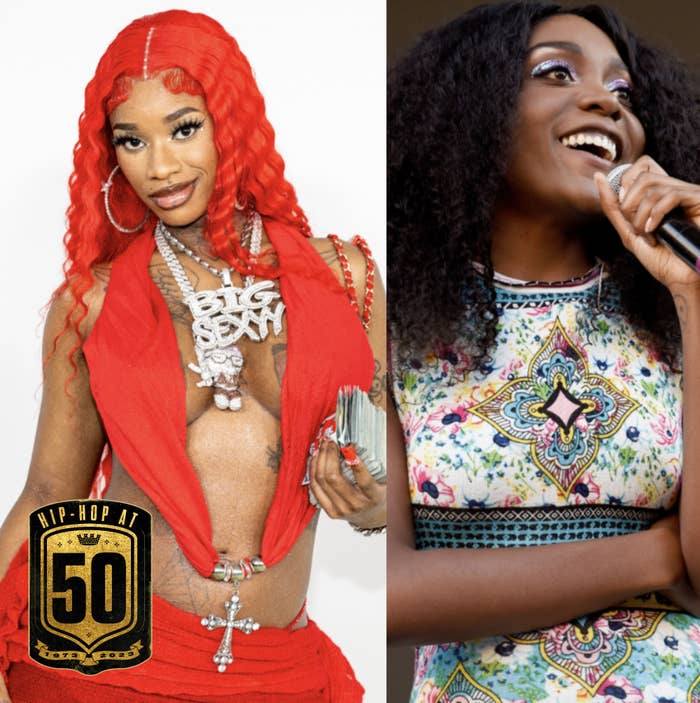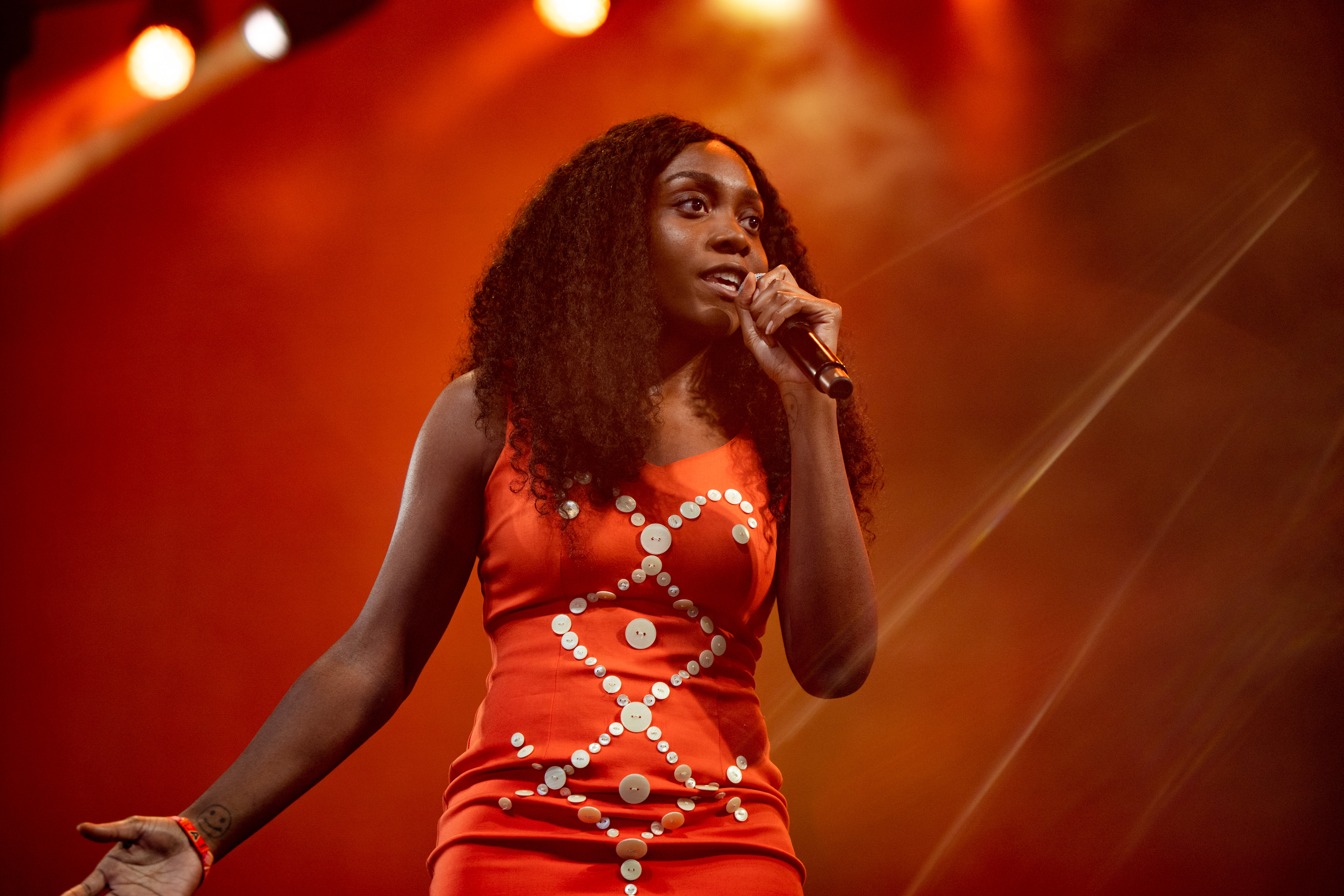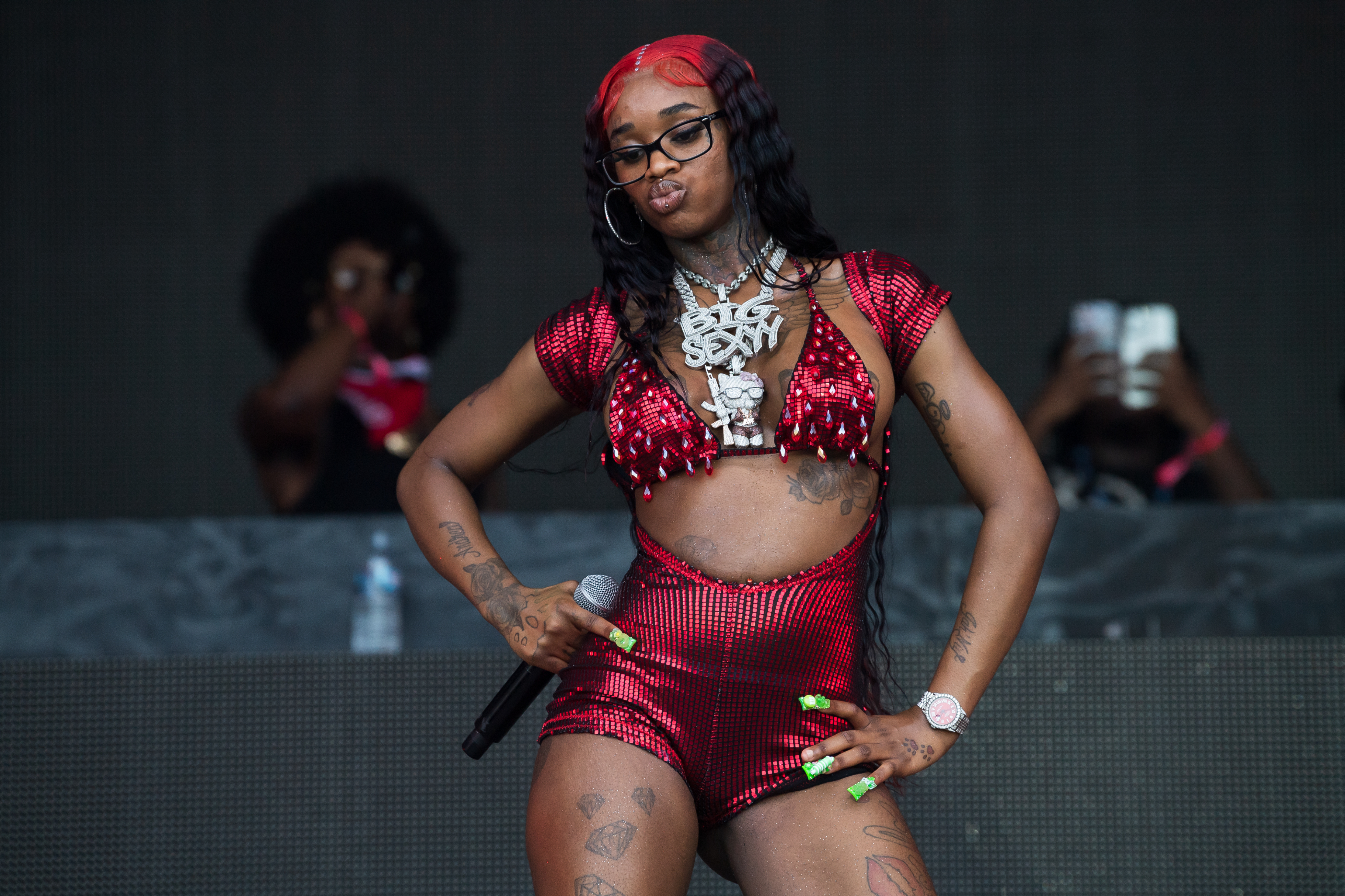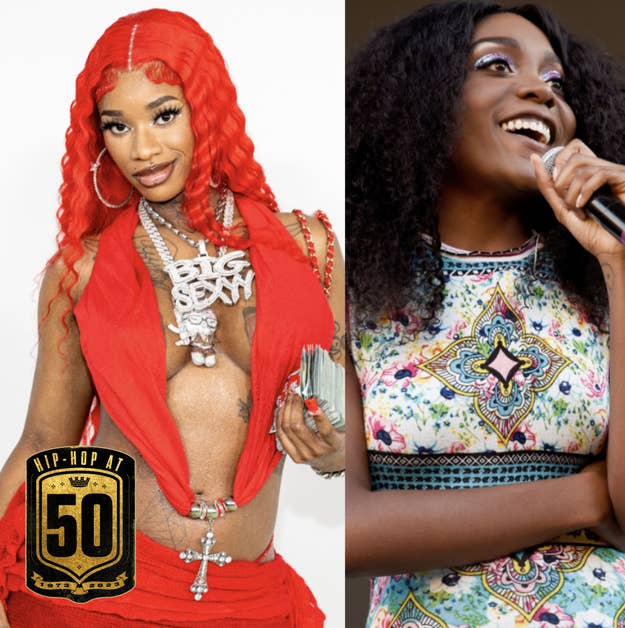
Terminal 5 is regarded by most New Yorkers as a shithole, a perception that is done no favors by the fact that the building housing the venue, on the Hudson River Waterfront in the northwestern corner of Hell’s Kitchen, presses against a modernist four-story Department of Sanitation garage that was once used for trash incineration, and is now home to hundreds of garbage trucks. It was once a club, and still looks like it, a warehouse that was hurriedly painted and lined with temp bars, bootlegged liquor, and a distressed sound system for an unlicensed word of mouth rave, or a fight club, or a sex club. On a Tuesday night before Halloween, it was briefly all of these things, held hostage by the breakout star of the year and crown jewel of the fall tour season, the St. Louis rapper Sexyy Redd, who came to town for a show that had to be added to her schedule after the first, at Irving Plaza, sold out in minutes.
Quietly, for those of us who spend too much time on our phones, it was a contentious summer in rap discourse. Amidst the triumphant, unlikely celebration of 50 years of hip-hop—full of long-overdue features, loving, nostalgia-tinged essays, and fantasy camp concert bills—a contrarian, strawman-packed strain of Gen-X counter narrative pushed back, arguing that all these ceremonies, all this press and hype and opportunities to collect checks and flowers for rap’s foundational, unsung legends, were bad, actually. That we were gathered here in honor of an empty, boring, white culture co-opted conglomeration of corporate interests, bereft of talent or fresh ideas, that bore little to no resemblance to an artform that was once inspired, boundary pushing, and exciting. The corpse had been drowned in the mainstream, and died long ago.
The critiques had the familiar bitter flavor of old-head gripe that have been essential to hip-hop’s narrative since its inception. The sort of convenient and intellectually lazy calls from inside the house, ingenious only in their incuriosity. It’s an ancient equation that says more about the critic leveling the misguided accusation: The music I fell in love with growing up has changed + I don’t like it anymore + That sucks = The music must now suck. As someone who grew up with and grew old with rap, I can relate—I’m an old head as well. But if I ever found myself sharing this sort of broad, echoed sentiment, I’d like to think that I’ve seen it proven wrong, seen these haters on the wrong side of history enough times to recognize it as a critical skill issue. The correlation between my life going stale, and the music I loved going stale at the same time, would simply be too great a coincidence to ignore.
To make matters worse, around the same period, Bed-Stuy native Fabolous, who was once a target of old-head ire because of his obsessive, one-note focus on materialism, drugs, and sex via clever, empty punchlines on Clue tapes, came out and criticized the state of women rappers as a monolith. In an attempt to present himself as a feminist champion that sailed wide left, the rapper who once said, “Pull it out like a pistol yo, kiss it on the balls like the dick a mistletoe,” said, “No disrespect to any female rappers out there, but I think there’s only one style of female rap/hip-hop being promoted, programmed, and looked at as successful now.”
This rash of the aforementioned “think” pieces and Fab’s dumb, misguided comments linked in my mind because of how easily, demonstrably wrong they were. And, to my dismay, both seemed to find a receptive audience who applauded the arguments for their truth-to-power bravery. I was stunned because it was apparent to me that anyone paying attention—exerting the bare minimum of effort at a time when rap has never been more accessible via technology, the music therein never more varied or plentiful—would know that rap is in great shape, currently being powered by a historically unprecedented women’s movement, a diverse, inspired, and rich coterie of young, gifted, and Black female MCs.
Proof of that, and further discourse on this moment in rap was found in the shows of Sexxy Red (in New York) and Noname (in Philadelphia)—two vital, diametrically opposed (in content) women rappers who dropped two of the year’s most defining projects, from two of rap’s oldest cities, with both concerts occurring less than a week apart.
"Rap is in great shape."
The artist and activist Noname, born Fatimah Warner, has spent a decade making rap influenced by spoken word. Coming off a five-year break, Sundial is a kind of culmination, a mature effort both sonically and in content that she has been building toward her entire career, and it’s been received as such. It’s a thorny personal and political mission statement that’s unsparing in its analytical assessment of culture and country, and the artist herself.
Because it’s a masterful balancing act of emotional and political content, full of expert rapping propped by expert singing, Sundial has been understood and reviewed as The Hotepization of Lauryn Hill, but it doesn’t have that album's slick and thermo-nuclear-powered anthemic pop. Instead, it’s closer to the early to mid-‘90s coffee house rap that influenced Lauryn, Arrested Development, Digable Planets, and No I.D. (With fellow Chicagoan Common). This can be found in the light, ruminative touch applied to the honey-drizzled Yamaha, walking bass lines, and hits of brass paired with the singer-rapper Chardonnay’s register as she all but scats on a guided tour of well-worn issues her wit and sharp pen breathe new life into: a Black woman's broken self-image in a mirror created by racist beauty standards, or rap’s complicity in the military-industrial complex.
Noname has perhaps inadvertently chosen to begin her tour the same evening as a Philly holiday. The title-contending Eagles are playing a national home game against the Miami Dolphins in primetime, and the city is effectively shut down. That isn’t to say there’s no appetite for the show, at the maybe 70-percent full Fillmore in Fishtown. The venue shares an industrial sensibility with Terminal 5, expressed by high ceilings and exposed pipes, but it’s a new construction in an open cul-de-sac with plenty of room to breathe inside and out.
Noname openly critiqued granting white America access to hip-hop, so one may wonder what she made of the makeup of the crowd that Sunday night. The majority of the audience wasn’t old enough to have voted for Bernie Sanders in 2016, but they all would have.

“Philadelphia, are you in the building with me or not?” Noname asked as she came out to “Black Mirror” with a five-piece band/Gen-Z Roots crew behind her, in a striped tee, pencil skirt, and a trucker hat over her waist-length braids, still girlish at 32. The answer shouted at the stage was a resounding “yes.” It was perhaps the entirety of the population of Philadelphia immune from Eagles and Phillies fever. The only sports paraphernalia I saw in the building was, oddly, a Dreamville jersey. Noname didn’t have any clothes at the merch table, just Sundial vinyls, and they were moving because there was a decent amount of people in the crowd hugging their plastic-wrapped copies. Most of the crowd didn’t know the words to every song, but the people who did absolutely needed you to know they did, and you could hear them all.
Noname is the rare live rap act that has no backing track; it was all live instrumentation and vocals. As a performer, she’s vulnerable and engaging, feeling her way through a set that she’s still working out, bringing the crowd into the process as she accidentally skips a verse here, or drops a punchline there, but has real chops. She was effortlessly controlling the mic and the stage, spitting with immaculate breath control and a real singing voice.
"Noname is a rare live rap act."
There were almost no phone operators with the exception of pocket cameras that came up sporadically for content. We were all generally subdued but locked in, rocking and nodding in place or spitting along, doing everything but snapping approval between songs, or screaming out political slogans. (In the midst of a few particularly difficult weeks, “FREE PALESTINE!” got the biggest response, and was echoed by Noname to unanimous applause.)
They eventually stopped playing after roughly an hour, not because they ran out of energy, but material from the 32-minute album. The show was a refuge from the open-air Temple frat-house energy that had the streets in a chokehold, as well as the general misery of mainstream America, in the midst of an international humanitarian crisis, with an election year looming. The building was united in politics, passion, and a progressive spirit that transcends conventional labels. As Noname walked off stage, I considered the relief, and catharsis I felt being in this venue, with this fan base. Noname accomplished the considerable feat of making the Fillmore feel more like a SNCC rally, or an Antifa protest, than a rap show.
Back in New York, I attended a radically different rally, which attracted a radically different crowd. The endless line stretches down West 56th Street and around 12th Avenue, overlooking the West Side Highway, the Hudson River, and the bejeweled skyline of Union City, New Jersey. It’s not a work function, but there is a uniform: low-rise jeans displaying g-strings, shirts jaggedly trimmed at the rib cage, reflective sunglasses at night, a neon rainbow of wigs (but mostly red), bottom lips pierced, and brows tattooed. Each person on this line has attained a golden ticket no football game could detract from. This is their Super Bowl.
Everyone is pleading, screaming, and jockeying for a glimpse of the high priestess Sexyy Red, who took the summer by storm with a mixtape that read America to filth and has done for sex rap what Young Jeezy once did for crack. Like Jeezy’s work with DJ Drama, Hood Hottest Princess strips away the writerly finesse on its exhibionist genre and deals frankly and directly in the minutia of its trade, in the process exposing how polite, cute and clever all missives on the subject were before each rapper exploded their respective paradigms. Sexyy doesn’t really rap about violence, and only discusses materialism—the predictable obsession of many of her both male and female peers—in passing. Sex is her sole passion and the subject matter she pursues with singular focus from every conceivable angle on every song. It’s Salt N Pepa taken to its apocalyptic, logical, and horny conclusion.
Sexyy catches dozens of bodies in each song, rapping in a dead-eyed, monotone shout that sounds like an NPC with the volume cranked, or a bored phone sex operator over sinister Memphis horrorcore-inspired production. The singularity of purpose and the delivery has a dulling effect, her music is a blunt object that beats you into submission. She is a rapper defined by her insatiable appetites and her unapologetic pursuit of them. Her size queen braggadocio is going far beyond the historically male-gazed, male-penned vision of fem sexuality that has dictated the tenor and language of the gangsta rap made by women since Hardcore.
Kaliii, a Panamanian rapper from Georgia whose similarly adept in rapping about sex, and Funkmaster Flex, who showed up for a brief, typically shouty and confrontational set, opened the night for Sexyy Red. Everyone was clearly thrilled to be there, but there was also hostile energy. Terminal 5 was a Black woman’s Themyscira that evening. Every dude was attached to a girl if not their girl, like a passport, holding on for dear life. People were jockeying for position as close to the stage as possible, hours before Sexyy’s set, ready with screw faces and raised eyebrows for anyone attempting to shoulder past. It was like a predominantly female and/or LGBTQ+ Onyx show where everyone was furiously throwing ass and getting sturdy instead of moshing and throwing bows.
These two shows were a state of rap’s union.
Finally, after about an hour of anxious dead time, Sexyy baptized the stage, in front of a minimalist set that was just a pyramid of monitors with LCD screens mostly displaying a cheap tie-dye screensaver-type backdrop. She was crowned with Inuyasha ears, a white bikini top, and cut-off jean shorts cinched with a thick bejeweled belt that looked like it belonged on a child in a Halloween costume or the WWE champion, doing splits and fucking the stage in towering clear platform heels, displaying her second trimester like a belly chain. Her four stripper/backup dancers came on and off, doing synchronized routines that could’ve made them rich at Pumps, in sleeveless, red crop tops with “Sexyy” printed across the chest and leather booty shorts. There was an ass-throwing contest, with women pulled from the crowd in competition, offering $200 for the winner. Or as Sexyy put it in her equal parts Midwestern and Southern fried-flyover state accent, “$40 for some dick—get some crab legs with the rest.” There were stacks of fake $100 bills with Sexyy’s visage on one side and the St. Louis arch on the other, thrown into the crowd by the fistful.
The sound was fucked, with the songs and guide vocals blasting so you could barely hear Sexyy’s mic, and it didn’t matter, because you wouldn’t be able to hear her either way over the crowd. Early on, I had been a Sexyy Red skeptic, because I was interested in trivialities like “cadence” and thought she was maybe a project or two away. I was disabused of this notion, as any critic would be, in a morass of thousands of women screaming each bar angrily, triumphantly at the stage, “C-C-Choke a bitch ass, make my face with your dick/Spit in my mouth, I want all that shit/Fuck me from the back, pull out phone and make a flick.” There’s nothing I can type that would match the carnal power of that experience. It was a pagan ritual masquerading as a rap show.
Contrasted with the Noname show a few days later, these two shows were a state of rap’s union: One artist is telling us Black feminism in 2023 through her art, and the other is showing us. A colleague who was also at the show shared a thought after:“(Sexyy) needs to concentrate less on shaking her ass and more on her flow.” I told them they missed the entire point.

Two powerful shows showcase two powerful albums by two powerful women artists in the same week, states apart, to wildly diverse, adoring crowds, and, for a moment, it was clear what the future of rap could be.
This doesn’t mean hip-hop hasn't picked up inevitable baggage in its 50 years of existence. There are goofy old spokespeople who were once great, who will likely continue parroting conservative talking points in their old age. There is the same pernicious influence of corporate money and “white culture” that infects every commercial product this country produces, and the accountability issue that permeates it. Rap by nature is vulgar and reactive and at times unnecessarily provocative and upsetting to older critics with more varied and nuanced worldviews. It is easy to take the bait, to follow in the traditions of our ancestors and turn on this artform whose relevance has impossibly outlived every other, and regurgitate the critical shit your parents once said, remixed and repackaged to prevent getting laughed out of the room, or off the Internet—but essentially lob the same sorts of criticisms that aren’t actually wrong, but like my colleague at Sexyy Red’s concert, entirely miss the point.
Because these lazy and boring gripes don’t account for the sweat pooling in your navel, the vibrations of thousands of people bouncing in rhythm, packed into a glorified median on the West Side Highway, the candy-colored light reflecting off a million teeth because everyone is smiling and/or screaming at the same time, the eternal ritual of young people who don’t know or don’t care about your history and the grip you lost on the culture years ago, gathering to worship at an altar that is always shifting in form but never changes. For them, hip-hop is as electrifying and all-consuming as it’s ever been, and they’re right, because it belongs to them now, is defined by them, and will be whatever they say it is.
My advice to all the old heads, both in years and in temperament, today, 50 years ago, and 50 years from now, is simple: If you ever find yourself possessed by a selfish spirit, suddenly unable or unwilling to see the life and energy that once animated the music, or the culture you loved, go outside.

